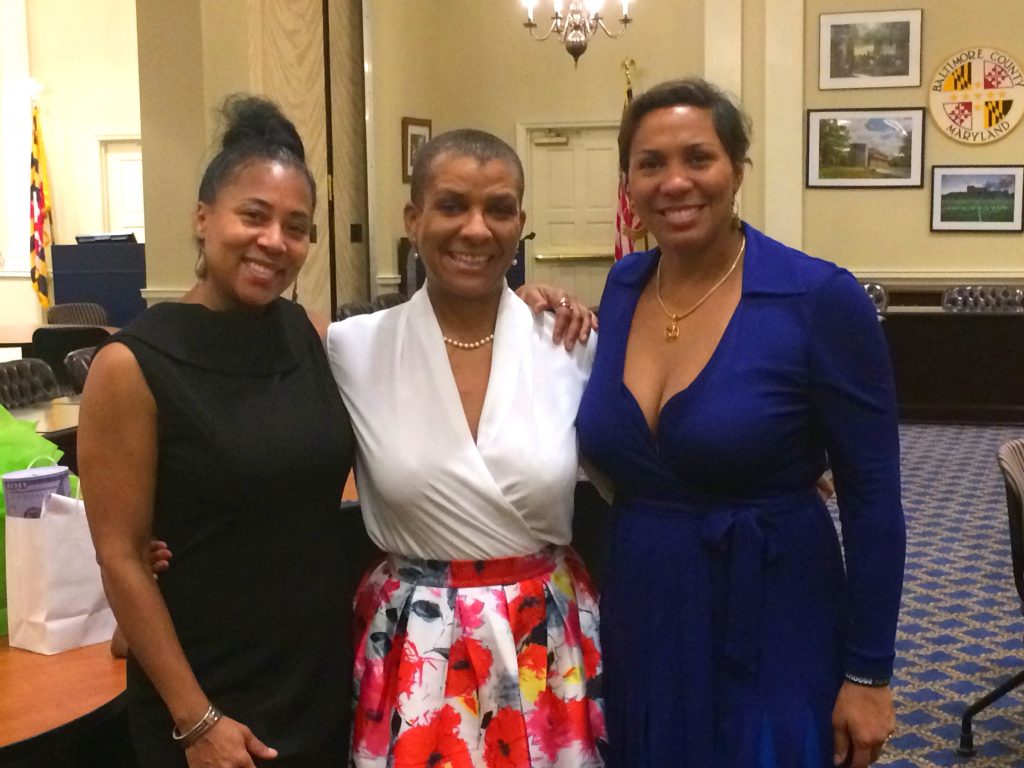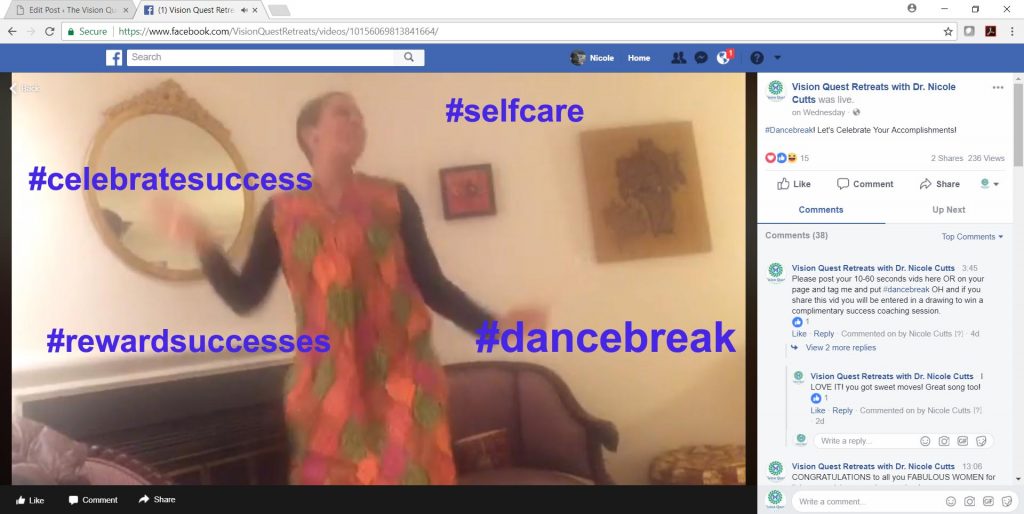By: Nicole Cutts, Ph.D.
Remarks Presented: March 6, 2018 at the 2018 Links at the Legislature, A day at the Maryland State House in Annapolis, MD Advocating for Policy to Improve the Health and Education of Children

with Montina Anderson & Monique Walker Anderson, Co-Chairs, 2018 “Links at The Legislature”
Introduction:
Some of the myriad challenges facing young people today are not new and have been experienced by adults of all generations but, many of these challenges are, in fact, new. The world has changed in an unprecedented way for young people, perhaps resulting in more isolation and existential angst than many adults today can identify with. In many ways the advancement of technology has increased the pace of life and, as a result, it has been harder for young people of today to mature and achieve social equilibrium and economic success.
While I will touch on many of these challenges the focus of my talk today is on how to build psychological resilience in our youth from both the standpoint of communities and individuals, by focusing on the keys to resilience.
I will present:
- Challenges facing young people today
- Definitions of resilience
- Keys to enhancing resilience, and
- How adults and youth themselves can help build resilience so young people can overcome any challenges they face today and for the rest of their lives.
I. The Challenges
Some of the pressures facing youth today include:
- Getting a good education in the face of declining quality of education, educational disparity, the competition and cost of getting into good colleges and universities.
- Balancing school, extracurricular activities and sports (especially when athletes are trying to get scholarships)
- The prevalence of medicines and alcohol and the rates of abuse of said substances.
- Gaining good employment and affordable housing in a shifting economy.
- Family problems like divorce of parents, splitting time between two households and being raised in single parent households.
- Obesity issues and the health consequences as well as body image pressures
- Racism, sexism and other forms of bigotry
- Pressures of 24-hour social networking and being online too much
- Violence in the world and schools in particular including bullying
- Growing up too fast including being sexually active and pressure to be.
- Pressures of materialism
- Erosion of National Pride and Identity, political strife
- Erosion of morality in society (bad leadership)
II. Definitions of Resilience
A. Resilience (General):
Resilience (derived from the Latin resilire) means to spring back or rebound.
Merriam-Webster (2018) defines resilience as 1: the capability of a strained body to recover its size and shape after deformation caused especially by compressive stress, and 2: an ability to recover from or adjust easily to misfortune or change.
The English Oxford Dictionary (2018) defines resilience as “The capacity to recover quickly from difficulties; toughness.”
Resilient (it’s adjective form) is defined as 1) (of a person or animal) able to withstand or recover quickly from difficult conditions and 2) (of a substance or object) able to recoil or spring back into shape after bending, stretching, or being compressed.
B. Community Resilience:
How each community conceptualizes and defines resilience matters because this will inform how you assess and then enhance your community’s resilience both before and after a crisis.
There are myriad definitions of community resilience. The one I perhaps like the most comes from Lesley Chenoweth and Daniela Stehlik’s (2001) article “Building resilient communities: Social work practice in Rural Queensland” and is “The ability to respond to crises in ways that strengthen community bonds, resources, and the community’s capacity to cope.”
Dr. Ann Masten (2014b), who has studied homeless families and young survivors of war and other severe adversities, defines resilience as “the capacity of a dynamic system to adapt successfully.”
As you can see from the definitions above, when applied to human beings, the term resilience implies what happens after a trauma or stressor.
Today I am going to discuss what can be done both before and in the midst of stress and or trauma to enhance the inborn resilience of youth.
III. Keys to Enhancing Resilience
A. Community Resilience
According to a report by the Post Carbon Institute (Lerch, 2015) there are six foundations that are essential to community resilience-building. These foundations support building community resilience, rather than achieving resilience as a fixed goal, so as to emphasize resilience building as an ongoing process.
The six foundations are:
- People. The power to envision the future of the community and build its resilience resides with community members.
- Systems thinking. Systems thinking is essential for understanding the complex, interrelated crises now unfolding and what they mean for our similarly complex communities.
- Adaptability. A community that adapts to change is resilient. But because communities and the challenges we face are dynamic, adaptation is an ongoing process.
- Transformability. Some challenges are so big that it’s not possible for the community to simply adapt; fundamental, transformative changes may be necessary.
- Sustainability. Community resilience is not sustainable if it serves only us, and only now; it needs to work for other communities, future generations, and the ecosystems on which we all depend.
- Courage. As individuals and as a community, we need courage to confront challenging issues and take responsibility for our collective future.
B. Individual Resilience
Some research has shown that resilience is ordinary, not extraordinary and that people commonly demonstrate resilience, but recent research may have debunked this long-held belief. Regardless, we know that resilience in human beings exists and research has been able to isolate factors that enhance it (which I will discuss in the next section).
According to the American Psychological Association “Resilience [in individuals] is not a trait that people either have or do not have. It involves behaviors, thoughts and actions that can be learned and developed in anyone.” (APA, 2018)
Keys to Building Individual Psychological Resilience:
There are several key factors that enhance the resilience of human beings.
Below I’ve named several factors:
1) Children Need Caregivers. One or more loving parent, guardian or caregiver increases children’s resilience. One way children experience love is through what David Richo (2001) calls the Five A’s. When we are children we need to receive this type of love from our parents in order to feel secure and to have the freedom to develop an identity separate from our parents.
1. Attention Notice, listen, focus and really engage with your child. Notice and hear words, feelings, experiences. Think about how your words and actions affect your son or daughter. (When we give someone this type of attention, they feel respected, understood and that they really matter to you.)
2. Acceptance Demonstrate in your words and actions that you approve of the person your child is, their unique personality traits, their values, their choices, their lifestyle. Acceptance means appreciating differences without judgment. (Acceptance leads to self-confidence and a sense of security).
3. Appreciation Express gratitude on a daily basis for who your child is and things they do. Say “thank you” for the individual qualities that you cherish, admire, or that make a difference in your daily interactions.
4. Affection Affection refers not just to physical closeness, but also feeling close to someone through conversation, gestures, and presence. Affection can be expressed through daily hugs, kisses, cuddles, thoughtful gestures, kind words and smiles.
5. Allowing Allowing means letting your son or daughter be themselves. It means giving them the freedom to do things in their own way [even to fail]. It means we don’t try to control or manipulate a person to make them what we want them to be or to do things the way we want them done. Of course, allowing doesn’t mean we accept behaviors that are truly dangerous or harmful to our child or others. Children need loving but firm boundaries. (Allowing increases a child’s self-esteem because it demonstrates confidence in them and their abilities)
2) Social Connections. Good relationships with close family members, friends or others are important. Accepting help and support from those who love you and will care for you strengthens resilience. Being active in civic groups, faith-based organizations, or other local groups provides social support. Assisting others in their time of need can also benefit the helper by building his or her self-esteem.
3) Optimism (a generally positive outlook on life). Staying positive and keeping fear and worry at bay helps people to maintain a hopeful outlook on life. This ability helps us reframe potentially negative events in a more positive or useful context. Model this optimism for your children.
4) Faith. Many people are made more resilient by the presence of faith, religion and spirituality in their lives. The practice of religion or spirituality often offers people support (previously mentioned as an important resilience factor) and this community can help with reclaiming hope after a trauma or setback. Expose your children to a faith that encompasses the Five A’s. Let them see your faith in action.
5) Keeping things in perspective. Taking a long-term perspective on life can help one to see that everything is temporary. Knowing that good periods as well as bad periods will pass allows one to avoid blowing all of life’s events (even disaster) out of proportion. Again, the best approach is to model this for your children, don’t just tell them, show them.
6) Positive Concept of Problems. Humans can’t change the fact that failures, disasters and other highly stressful events occur, but we can change how we interpret and thus respond to these events. It’s easy for our brains to create negative narratives around difficult events so purposely creating positive and even neutral story lines may take work but this will improve ones overall mental health and enhance resilience. EXAMPLE: I encourage my clients to envision their lives as hero/heroine quests and to conceptualize challenges as necessary “trials” and ordeals as “dragons” to be slain. Both are necessary for the ultimate victory of the hero or heroine. If your child is creating negative narratives around a stressful event ASK them if there could possibly be any other interpretation.
7) Let Your Children Fail! German philosopher, Friedrich Nietzsche said “That which does not kill us, makes us stronger.” And he is correct. Psychologist, Martin Seligman has discovered a phenomenon he calls Post Traumatic Growth (PTG). PTG refers to any beneficial change resulting from a major life crisis or traumatic event. People most commonly experience this from a positive shift, having a renewed appreciation for life and adopting a new world view with new possibilities for themselves; feeling more personal strength; and feeling more satisfied spiritually. Keep in mind that failure alone does not always lead to increased resilience but it’s more likely to when combined with the key resilience factors named above and below. Again, it’s best to model these perspectives and lead your children to them by asking questions about how they feel and what they wish to do verses telling them how to be.
8) Having a Purpose! Having a purpose not only gives your life meaning but it can actually increase psychological well-being and help to inoculate you against despair or hopelessness. Having a purpose also helps you to frame crisis differently and increases your power. Model your purpose for your children and ask them questions about their life’s purpose and meaning. Additionally, taking action about a stressful event builds resilience. Ask young people what they can do about things like gun violence, inequality and political strife and facilitate action on their part.
9) Acceptance of change (as a normal part of life). Resistance to change brings more suffering and depletes the power and energy of the sufferer. Accepting circumstances that cannot be changed can help you focus on circumstances that you can alter. Frame change as normal and model a positive reaction to it.
10) Taking care of yourself. Take care of your physical health and general wellbeing and encourage and facilitate your children to do the same. Show them that hard work is necessary and so is rest and self-care.
11) Saying an Unconditional YES to Life! Acceptance of life exactly as it is leads to lower stress levels. Acceptance of powerlessness over stressful situations builds resilience. Model this for your children. Start off by embracing these five unavoidable givens in life.
Learn these Five Things We Cannot Change (If you don’t already know them).
From David Richo’s (2005) book The Five Things We Cannot Change and the Happiness We Find by Embracing Them he says,
“There are five unavoidable givens, five immutable facts of life built into the very nature of things, over which we are powerless:
- Everything changes and ends.
- Things do not always go according to plan.
- Life is not always fair.
- Pain is part of life.
- People are not loving and loyal all the time.
Too often we behave as if somehow these givens aren’t always in effect or are not applicable to all of us. But when we oppose these five basic truths we resist reality, and life becomes an endless series of disappointments, frustrations, and sorrows. Once we learn to accept and embrace these fundamental facts, however, we come to realize that they are exactly what we need to gain courage, compassion, and wisdom — in short, to find real happiness.” (Richo, 2005)
How to Teach/Coach Resilience (specific methods and tools)
Before a Traumatic Event or Disaster
In addition to the above factors, Martin Seligman’s (2011) PERMA model of psychological well- being may also be useful when teaching and modeling for your children prior to any trauma or stressors. PERMA is an acronym for positive emotion, engagement, relationships, meaning, and accomplishment—the building blocks of resilience and growth:
Positive emotions – feeling good
Engagement – being completely absorbed in activities
Relationships – being authentically connected to others
Meaning – purposeful existence
Achievement – a sense of accomplishment and success
After a Failure, Set Back or Traumatic Event
The goal of therapeutic interventions after a traumatic event or failure are usually focused on getting the person affected back to “normal.” But pioneering psychologist Martin Seligman has been helping people, especially soldiers to “grow” from trauma.
In August 2008 the Comprehensive Soldier Fitness (CSF) training was established by then-Chief of Staff of the United States Army, Gen. George W. Casey, Jr., in an effort to address the challenges being faced due to multiple deployments required by persistent conflicts in Iraq and Afghanistan. Instead of focusing only on treatment after the issues arose, Casey wanted to also provide preventative measures to the soldiers, their families and Army civilians to make them stronger on the front end. CSF Resilience Training was created to give these individuals the life skills needed to better cope with adversity and bounce back stronger from these challenges.
Martin Seligman devised the Resilience Training component of the CSF. Through years of research (to include his discovery of learned helplessness) he found that, “How human beings react to extreme adversity is normally distributed. On one end are the people who fall apart into PTSD, depression, and even suicide. In the middle are most people, who at first react with symptoms of depression and anxiety but within a month or so are, by physical and psychological measures, back where they were before the trauma. That is resilience. On the other end are people who show post-traumatic growth. They, too, first experience depression and anxiety, often exhibiting full-blown PTSD, but within a year they are better off than they were before the trauma. These are the people of whom Friedrich Nietzsche said, “That which does not kill us makes us stronger.” (2011)
Seligman (2011) told General Casey that the army could shift its distribution toward the growth end by teaching psychological skills to stop the downward spiral that often follows adversity. He ordered the organization to measure resilience and teach positive psychology to create a force as fit psychologically as it is physically.
The CSF Resilience Training’s mandatory module, on post-traumatic growth (Tedeschi & McNally, 2011) is based on “the ancient wisdom that personal transformation comes from a renewed appreciation of being alive, enhanced personal strength, acting on new possibilities, improved relationships, or spiritual deepening. The module interactively teaches soldiers about five elements known to contribute to post-traumatic growth:
- Understanding the response to failure or trauma, which includes shattered beliefs about the self, others, and the future. This is a normal response, not a symptom of PTSD or a character defect.
- Reducing anxiety through techniques for controlling intrusive thoughts and images.
- Engaging in constructive self-disclosure. Bottling up trauma can lead to a worsening of physical and psychological symptoms, so soldiers are encouraged to tell their stories.
- Creating a narrative in which the failure is seen as a fork in the road that enhances the appreciation of paradox—loss and gain, grief and gratitude, vulnerability and strength. The narrative specifies what personal strengths were called upon, how some relationships improved, how spiritual life strengthened, how life itself was better appreciated, or what new doors opened.
- Articulating life principles. These encompass new ways to be altruistic, crafting a new identity, and taking seriously the idea of the Greek hero who returns from Hades to tell the world an important truth about how to live.” (Seligman, 2011)
Building Mental Toughness ABCDE Model of Emotional Disturbance
Albert Ellis’s ABCDE Model of Emotional Disturbance (Ellis & Dryden, 1987) is often used in different resilience programs and is particularly useful in breaking down a given adversity and seeing how it’s our beliefs about what happened that are causing us to feel a certain way, not the event itself.
This model allows for a greater level of awareness about our own reactions and subsequently a more adjusted and healthy response to adversity.
Albert Ellis developed an ABCDE format to teach people how their beliefs cause their emotional and behavioral responses: ‘A’ stands for activating event or adversity. ‘B’ refers to one’s irrational belief about ‘A.’ That belief then leads to ‘C,’ the emotional and behavioral consequences. ‘D’ stands for disputes or arguments against irrational beliefs. ‘E’ stands for new effect, or the new, more effective emotions and behaviors that result from more reasonable thinking about the original event.
Let’s take a look at an example explaining the ABCDE model:
- Activating event – You fail a test or don’t get into the school of your choice.
- Belief about the event – You believe, “I’m a failure. I will never be successful.”
- Emotional or behavioral response – You feel depressed and stop trying to do better in school.
- Disputation – You realize that you are not a failure because you failed one test or any one thing. So, you realize that you being a failure may not be true nor is it true that you will never get succeed.
- New effect/emotions and behaviors – You feel disappointment and sadness but have hope and begin the process of rebuilding your educational vision and creating a strategy for yourself to succeed.
Other Treatment Modalities to Consider:
Logotherapy*
Logotherapy is a term derived from “logos,” a Greek word that translates as “meaning,” and therapy, which is defined as treatment of a condition, illness, or maladjustment. Developed by Viktor Frankl, the theory is founded on the belief that human nature is motivated by the search for a life purpose; logotherapy is the pursuit of that meaning for one’s life. Frankl’s theories were heavily influenced by his personal experiences of suffering and loss in Nazi concentration camps.
Finding Meaning with Logotherapy
Logotherapy is based on the premise that humans are driven to find a sense of meaning and purpose in life. According to Frankl, life’s meaning can be discovered in three different ways:
- By creating a work or accomplishing some task
- By experiencing something fully or loving somebody
- By the attitude that one adopts toward unavoidable suffering
Frankl believed that suffering is a part of life, and that man’s ultimate freedom is his ability to choose how to respond to any set of given circumstances, even the most painful ones. Additionally, people can find meaning in their lives by identifying the unique roles that only they can fulfill. For example, when a man consulted with Frankl due to severe depression following the death of his wife, Frankl asked him to consider what would have happened if he had died first and his wife had been forced to mourn his death. The man was able to recognize that his own suffering spared his wife from having that experience, which served as a curative factor and helped relieve his depression.
* Good Therapy.org












